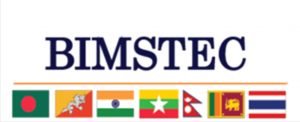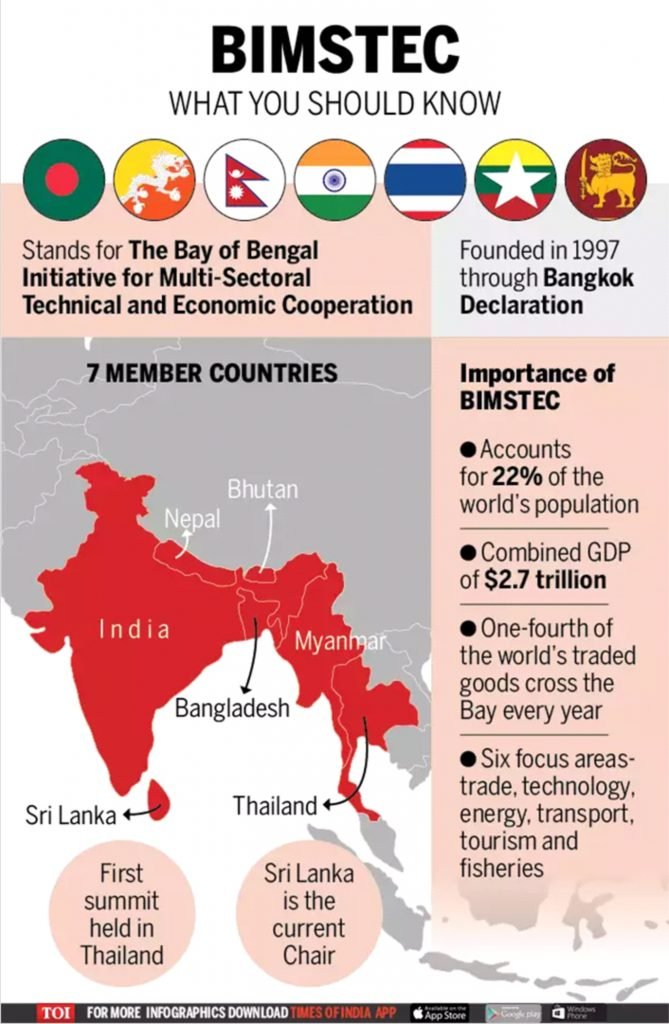Current Affairs (3rd April 2021)
Connectivity master plan for BBR
Context:
- The virtual meeting of the Foreign Ministers of Bay of Bengal Multi-Sectoral Technical and Economic Cooperation (BIMSTEC) grouping finalised a major Connectivity master plan for the Bay of Bengal region.
About:
- The seven-member regional grouping namely India, Bangladesh, Nepal, Bhutan, Sri Lanka, Thailand and Myanmar will take up the Master plan for transport connectivity for adoption in the next summit of the organisation to be hosted by Sri Lanka in a few months from now.

- The meeting also endorsed three MoUs/agreements relating to convention on Mutual Legal Assistance in Criminal matters, cooperation between diplomatic and training academies and establishment of BIMSTEC Technology Transfer Facility in Colombo.
- The connectivity master plan is the outcome of more than a decade of consultations among the member states.
- The study conducted by the Asian Development Bank (ADB) in 2007 and 2014, identified 166 connectivity projects at an estimated cost of USD 50 billion out of which 65 projects were identified as priority projects.

ACT-Accelerator
Context:
- Tedros Adhanom Ghebreyesus, the director-general of the World Health Organization (WHO), appointed Carl Bildt as WHO Special Envoy for the Access to COVID-19 Tools Accelerator (ACT-Accelerator).
About:
- It was launched in the month of April, 2020 at an event co-hosted by the Director-General of the World Health Organization (WHO), the President of France, the President of the European Commission, and the Bill & Melinda Gates Foundation.
- The ACT-Accelerator is a groundbreaking global collaboration to accelerate development, production, and equitable access to novel corona virus disease (COVID-19) tests, treatments and vaccines, according to the WHO website.
- It brings together governments, scientists, businesses, civil society, and philanthropists and global health organizations.
- These include the Bill & Melinda Gates Foundation, CEPI, FIND, Gavi, The Global Fund, Unitaid, Wellcome, the WHO and the World Bank.
- It aims toend the pandemic, restore full societal and economic activity globally and facilitate high-level control of Covid-19 disease.
- COVAX is one of four pillars of the ACT Accelerator.
- It is an effort to ensure that people in all corners of the world will get access to Covid-19 vaccines, regardless of their wealth.
- It is co-led by Gavi, the Coalition for Epidemic Preparedness Innovations (CEPI) and the World Health Organisation (WHO), working in partnership with vaccine manufacturers of developed and developing countries.
Pakistan lifts ban on Indian Imports
Context:
- Pakistan recently decided to lift its nearly two-year ban on imports of cotton and sugar from India.
India-Pakistan trade before ban
- Given their tumultuous relationship, trade between the neighbours has always been linked to politics.
- So, India’s exports to Pakistan fell around 16 per cent to $1.82 billion in 2016-17 from $2.17 billion in 2015-16 after relations deteriorated in the aftermath of the Uri terror attack and the Indian Army’s surgical strikes on militant launchpads in Pakistan-occupied Kashmir in 2016.
- Despite continuing tensions, trade between the two countries grew marginally in subsequent years; Indian exports rose nearly 6 per cent to $1.92 billion in 2017-18, and then by around 7 per cent to $2.07 billion in 2018-19.
- Imports from Pakistan, though much less in volume, also increased by 7.5 per cent to $488.56 million in 2017-18 from $454.49 million in 2016-17.
- Growth of imports from Pakistan slowed to around $494.87 million in 2018-19 — an increase of around 1 per cent – before political relations entered a deep freeze in 2019.
- Major products traded
- Over the years, India has had a trade surplus with Pakistan, with much less imports than exports. Pakistan was among India’s top 50 trade partners in 2018-19, but was pushed out of the list in 2019-20. It had been anticipated that a trade ban between the countries would affect Pakistan more, since it relied heavily on India for key raw materials for its textiles and pharmaceuticals industries.
- In 2018-19, cotton ($550.33 million) and organic chemicals ($457.75 million) accounted for around half of Pakistan’s imports from India.
- Other major Pakistani imports from India that year included plastic ($131.19 million), tanning/dyeing extracts ($114.48 million), and nuclear reactors, boilers, machinery, and mechanical appliances ($94.88 million).
- After the ban, imports of these five products fell drastically to $1 million to $2 million between April 2020 and January 2021, while cotton imports stopped altogether.
- The only increase has been in pharmaceutical products – Pakistan has so far imported around $67.26 million worth of drug products, and over $115 million worth of organic chemicals to ensure sufficient supplies of medicines during the Covid-19 pandemic.
- India’s major imports from Pakistan in 2018-19 were mineral fuels and oils ($131.29 million), edible fruits and nuts ($103.27 million), salt, sulphur, stone and plastering materials ($92.84 million), ores, slag and ash ($17.18 million) and raw hides and leather ($16.27 million).
- The country imported these products in substantially higher volumes from other countries – $25.51 billion worth of mineral fuels and oils from Saudi Arabia; $840.80 million in edible fruits and nuts from the US; $566.52 million in salt, sulphur and plastering materials from the UAE; $862.00 million in ores, slag and ash from Chile; and $83.36 million in raw hides, skin and leather from Italy.
Pakistan’s trade ban
- Pakistan’s decision to suspend bilateral trade with India in August 2019 was a fallout of the constitutional changes in Jammu and Kashmir, which Pakistan said were “illegal”.
- However, an underlying reason for suspending trade was the 200 per cent tariff imposed by New Delhi on Pakistani imports earlier that year after India revoked Pakistan’s Most Favoured Nation (MFN) status in the aftermath of the Pulwama terrorist attack.
- Trade between the two countries suffered greatly – India’s exports to Pakistan dropped nearly 60.5 per cent to $816.62 million, and its imports plummeting 97 per cent to $13.97 million in 2019-20.
Why the change
- The Pakistani decision to lift the ban on cotton imports comes in the backdrop of a shortage in raw material for Pakistan’s textile sector, which has reportedly suffered due to low domestic yields of cotton. Also, imports from countries like the US and Brazil are costlier and take longer to arrive.
- The decision on sugar was dictated by high domestic prices. Pakistani sugar imports in the period July 2020-February 2021 zoomed to 278,733 metric tonnes from 4,358 metric tonnes in the same period in 2019-20.
Global Gender Gap Report
Context:
- Global Gender Gap Report 2021 has been released by the World Economic Forum.
About:
- India has fallen 28 places and is now one of the worst performers in South Asia, trailing behind neighbours Bangladesh, Nepal, Bhutan, Sri Lanka and Myanmar -— it is now ranked 140 among 156 countries.
- South Asia incidentally is one of the worst performing regions, followed only by the Middle East and northern Africa.
- The report points out that many countries have fared worse in this year’s rankings compared to last year’s, on account of economic performance.
- Globally, the average distance completed to parity is at 68 per cent, a step back compared to 2020 (-0.6 percentage points).
- These figures are mainly driven by a decline in the performance of large countries. On its current trajectory, it will now take 135.6 years to close the gender gap worldwide.
- The gender gap in political empowerment remains the largest: women represent only 26.1 per cent of some 35,500 parliament seats and just 22.6 per cent of over 3,400 ministers worldwide. In 81 countries, there has never been a woman head of state, as of January 15, 2021.
- While India has declined on the political empowerment index as well by 13.5 percentage points, and a decline in the number of women ministers, from 23.1 per cent in 2019 to 9.1 per cent in 2021, it has still performed relatively well compared to other countries, ranking at 51 in women’s participation in politics.
- Bangladesh is the only country where more women have held head-of-state positions than men in the past 50 years.
- In the index of education attainment, India has been ranked at 114.
- But the two indices where India has fared the worst are “Health and Survival”, which includes the sex ratio, and economic participation of women.
- The second-largest gender gap among the four components of the index is for the Economic Participation and Opportunity subindex. Only 3 per cent of this gap has been closed so far (globally).
- The countries with the largest gender gaps in economic participation include Iran, India, Pakistan, Syria, Yemen, Iraq, and Afghanistan.
- The economic participation gender gap actually widened in India by 3 percent this year. The share of women in professional and technical roles declined further to 29.2 per cent.
- The share of women in senior and managerial positions also is at 14.6 per cent and only 8.9 per cent firms in the country have top female managers.
- The estimated earned income of women in India is only one-fifth of men’s, which puts the country among the bottom 10 globally on this indicator.
- But it is in the Health and Survival index that India has fared the worst, ranking at 155 — the only country to have fared worse is China. The report points to a skewed sex ratio as a major factor.
- It will take South Asia 195.4 years to close the gender gap, while Western Europe will take 52.1 years.
- While ranking India at 155 — a spot ahead of China — on the health and survival index, the report points to a skewed sex ratio as the major factor.
- It says the ratio can be attributed to norms of son preference and gender-biased prenatal sex-selective practices.
- China and India together account for about 90 to 95 per cent of the estimated 1.2 to 1.5 million missing female births annually worldwide due to gender-biased prenatal sex selective practices.


